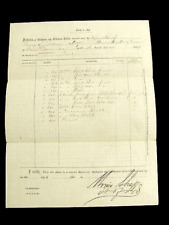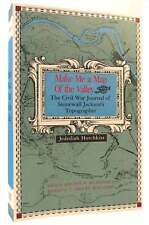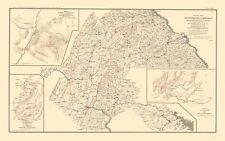Heat.net Store Home
|
Hotchkiss Civil War Artillery Shell Dug By Old Time Relic Hunter Wilber Bedall For Sale


When you click on links to various merchants on this site and make a purchase, this can result in this site earning a commission. Affiliate programs and affiliations include, but are not limited to, the eBay Partner Network.

Hotchkiss Civil War Artillery Shell Dug By Old Time Relic Hunter Wilber Bedall :
$162.50
Description Click to EnlargeClick to EnlargeClick to EnlargeClick to EnlargeClick to EnlargeClick to EnlargeClick to EnlargeClick to EnlargeClick to EnlargeClick to Enlarge Civil War bronze fused Hotchkiss shell dug by old time relic hunter Wilbur Bedall. The nose section and bottom section are in two pieces that you can fit together. They have been cleaned and coated. Either Bedall or someone he knew has drilled down through bronze fuse and into the center of the shell to empty out the powder and render the shell inert or harmless. It was recovered on private property with permission. The last picture shows a few of the other shells and cannonballs he dug that I will be listing individually. Here is a write up about Mr. Bedall for those who are interested:Mr. Bedall was born May 15, 1929, in Akron, Ohio. From approximately age 6 to age 15, his family lived in Burkeville, Nottoway County, Virginia. He attended grade school at Burkeville. Mr. Bedall’s father managed Sunnyslope Orchard in Burkeville whose produce included apples and peaches. As a boy, Mr. Bedall found scores of old lead bullets from the Civil War in the peach orchard portion of the farm. Many an afternoon, Mr. Bedall’s pockets would be so full of the lead bullets he would have to hold up his pants with his hands to keep the weight of the bullets from pulling them down. Here is the story of the Civil War bullets at Sunnyslope Orchard which young Mr. Bedall found easily and in abundance. After General Lee’s surrender at Appomattox Court House, Union forces moved east to the area of Burkeville Junction. Burkeville Junction was strategic for transportation, being located at the intersection of the South Side Railroad and the Richmond and Danville Railroad. The South Side Railroad provided east-west access from Petersburg to Lynchburg. The Richmond and Danville Railroad provided north-south access to its namesake cities. A portion of the property which the Union Army occupied at Burkeville Junction became, in time, Sunnyslope Orchard. During their time in this area, Union soldiers discarded surplus material on the property, apparently including lots and lots of bullets. Many decades later, the sandy loam soil of this region made finding discarded, surplus bullets easy. The 15 or so acres of peach orchard was cultivated periodically to help prevent brown rot. When hard rains came, the cultivated, sandy loam soil easily washed out. As the surface water washed down gentle slopes, the heavy lead bullets, carried by the rain run-off, congregated in the low spots of shallow wash-outs. The exposed bullets with their bright, white oxidized outside layer were an easy find for the curious schoolboy. One of Mr. Bedall’s childhood pastimes was casting toy lead soldiers using a mould he had received as a childhood Christmas present. The Civil War bullets provided much metal for casting these soldiers. Mr. Bedall melted these bullets in a spoon by holding spoon with bullet(s) in the flue damper of the kerosene heating stove that sat in the living room of his family’s home. Mr. Bedall excelled at finding things from childhood. One day as a boy, while waiting at the end of his driveway for the school bus, he found an 1840 half-dime in a mud puddle. In those days, one could buy stamps from the mail carrier by leaving money in the mailbox to pay for the purchase. Mr. Bedall speculates that the coin was dropped at some point in the exchange between mail carrier and stamp purchaser. He still has the half-dime in his collection today. Mr. Bedall – Relic Hunter Extraordinaire In the 1980s, Mr. Bedall was introduced to relic hunting by a friend. The friend had a spare metal detector and took Mr. Bedall to relic hunt near Cross Keys Civil War Battleground in the Shenandoah Valley. Mr. Bedall was unfamiliar with metal detectors and their operation, he queried his friend repeatedly about detector signals as he tried to figure out exactly what it was that he was supposed to be doing. “Should I dig this signal? Should I dig that signal?” Eventually the friend told him he was just going to have to figure it out himself. About three signals later, Mr. Bedall heard a strong, steady signal; his friend confirmed that this was a good signal. Mr. Bedall started to dig. At 12 inches deep he had not found anything but the signal was still there and stronger. About 6 inches deeper Mr. Bedall struck something with his shovel that felt and sounded like a rock. It wasn’t a rock. It was a Hotchkiss 3.67” shell which had been fired from a Union cannon. The shell was intact and complete except for the anvil! On his first expedition, Mr. Bedall had made a significant find. Mr. Bedall related that this find “lit him up like 110 volts of electricity lights up an incandescent light bulb”. This began a 30 year career as Civil War relic hunter extraordinaire. Mr. Bedall has relic hunted, with owner permission, on private land associated with the following 24 Civil War battlefields. - Bartow WV
- Boteler’s Ford
- Burkville
- Cedar Creek
- Cedar Mountain, Culpeper County, VA
- Cross Keys, Rockingham County, VA
- Culpeper
- Fisher’s Hill, Shenandoah County, VA
- Fredericksburg, Fredericksburg and Spotsylvania County, VA
- Freeman’s Ford, Culpeper County and Fauquier County, VA
- Harrisonburg – Carr’s Camp, Rt 11 N
- Kernstown
- McDowell, Highland County, VA
- Milford (Overall), Warren County, VA
- Mine’s Run
- New Market, Shenandoah County, VA
- Piedmont, Augusta County, VA
- Port Republic, Rockingham County, VA
- Rude’s Hill
- Totopotomoy Creek
- Trevilian Station, Louisa County, VA
- Wilderness
- 1st Winchester
- 2nd Winchester
- 3rd Winchester
Mr. Bedall has also relic hunted on private land near to Fort George (Castine, ME), an earthworks fort built in 1779 by Great Britain during the American Revolutionary War. Stories – Mr. Bedall’s Relic Collection Mr. Bedall documented his many relic discoveries. He always obtained permission from private landowners before he hunted relics on their property. The first time he would dig relics on an owner’s property, he would often take them and show them where he had dug a signal and the replaced the soil and sod so there was almost no evidence of his having disturbed the ground. Mr. Bedall discovered thousands of Civil War bullets and hundreds of Civil War artillery shells. Near Culpeper, VA, he once found 1600 unfired and discarded bullets in a latrine area where the Union Army (under General Hancock) had camped the winter of 1862. The Union Army had standardized on 58 caliber Springfield rifles and ammunition at the time. The bullets that were discarded were for other arms of other calibers: 54 caliber, 68 caliber and 69 caliber. Mr. Bedall’s area of special interest is Civil War artillery shells. His personal collection of Civil War artillery shells is tabulated at the end of this article. The great majority of the artillery shells were found by Mr. Bedall. A small number of rare or unusual shells he purchased. Many of the Union Army artillery shells were Hotchkiss patent shells. These shells were made in three parts: a nose section containing the explosive charge, a cast iron cup fitted on the bottom, and lead band sabot cast around the middle. Upon being fired from a cannon, the cup would compress the lead band sabot causing it to expand and fill the rifling of the cannon barrel. A shell with a solid nose was called a bolt. A shell with a fuzed, explosive charge of black powder inside the cast iron nose was called a shell. A shell with a fuzed, explosive charge and grapeshot (or similar) shrapnel packed with the black powder was called case shot. A variety of fuzes were used to cause the black powder charges inside the shells to explode. One simple type of fuse was a tapered “cigarette” style fuse with a compressed column of black powder inside instead of tobacco. [This is called a simple combustion delay element.] The muzzle flash from the cannon would ignite the end of this type of fuse; the length of the fuse and how it was assembled determined how long the fuse burned before it the spark got to the black powder. Fuses were timed for 5 seconds, 10 seconds, etc. A 10 second fuse could be “adjusted” to be an 8 second fuse by “cutting the fuse” shorter according to marks on the side of the fuse body. Early Hotchkiss shells had a round middle profile; one problem of this design was that some percentage of the “cigarette” type fuses failed to light from the muzzle flash. Later Hotchkiss shells had three grooves cast length-wise and equidistant around the perimeter of the shell. The flash from the black powder firing charge could reach and ignite the fuse during the shell’s journey down the barrel of the cannon, thus reducing the percentage of shells with unlit fused that never exploded. Mechanical fuzes were also used to trigger the shell’s explosive charge. The percussion fuze is one example: a hollow brass tube contained a plunger held in place by a small screw. When the shell was fired from the cannon, the screw would shear apart and the plunger was free to move. When the shell hit the ground, a percussion cap on the end of the plunger would slam forward and fire. The percussion cap flash ignited the primer in the plunger which exploded the shell. The percussion fuze had a small screw cap on its front (nose) end; one side of the screw cap was flat and the other side was recessed. For safety during transportation and storage, this screw cap would be installed with its recessed side facing the percussion cap thus preventing the percussion cap from being triggered. To arm the shell, the screw cap was removed and reversed, the flat side now faced the percussion cap. This made an anvil surface for the percussion cap to hit on impact, triggering the cap and exploding the shell. Some of the artillery shells that Mr. Bedall found were still armed with live mechanical percussion fuses and lots of old black powder packed inside. Mr. Bedall carefully disarmed these shells and removed the black powder. On one occasion after he had dug most of the black powder out of an old shell, he then emptied the remaining residue by lighting it using a long fuse. From a safe distance Mr. Bedall watched the black powder light off, emitting a gigantic puff of smoke the size of several train boxcars. Mr. Bedall found scores of pieces of shrapnel from artillery shells that had exploded. Sometimes an artillery shell was fused to explode in the air and sometimes it was fused to explode when it hit the ground, called a ground burst. When Mr. Bedall would locate the area of a ground burst shell, sometimes numerous pieces of the shrapnel would still be close to each other. Mr. Bedall would dig the area of the ground burst, keeping the pieces of shrapnel together. Later, after he had cleaned the shrapnel, removing dirt and rust, he could see how the pieces fit back together. Mr. Bedall re-assembled numerous ground burst shells. One groundburst that Mr. Bedall dug was in a garden in New Market on the land of a Mr. Register. The groundburst was a 3½” shell; when he was done excavating all the shrapnel he could find he had a hole 3 feet in diameter and 3 feet deep. On at least one occasion, Mr. Bedall found shrapnel from 2 ground burst shells in the same immediate area. After all the pieces were cleaned, he was able to re-assemble not one but two nearly complete shells, all the shrapnel coming from the same small area of the battlefield. While Mr. Bedall’s find of an artillery shell on his first outing was beginners luck, his subsequent success was due in part to thoughtful and diligent research. One example was his study of the battlegrounds of the Battle of Cross Keys. Mr. Bedall found a number of Union artillery shells on the bluff in front of where the Confederate cannon were located on the backside of the bluff. Researching the locations of Union cannon positions combined with knowledge of the locations of Confederate cannon positions allowed Mr. Bedall to estimate trajectories of Union shells. Since he had found Union shells that landed short of the Confederate cannon positions, he reasoned that he would likely find Union shells that overshot the Confederate positions. When Mr. Bedall walked down the trajectories and searched his estimated overshot zone, he indeed found Union shells that were overshots just as he had postulated. Mr. Bedall has discovered many other kinds of metal relics, like buckles from belts and shoes, buttons from uniforms, and shoes from animals (horse, oxen). An uncle to Mr. Bedall lived in a home in the Fan District of Richmond, capital of the Confederacy. One day while working on his furnace, the uncle knelt and his knee landed on a hard object. Hurting as it did, the uncle did not want to kneel again on the object so he stuck it in his pocket. Back upstairs he discovered he had found a button from a Confederate soldier’s uniform. After years passed, Mr. Bedall’s cousin, the daughter of his uncle, lived in the same Fan District house. Mr. Bedall asked her if he could look around in the basement and she gladly agreed. Mr. Bedall found three more Confederate uniform buttons that matched the one found by his uncle. He also found a New Jersey uniform button. Uniform buttons could be hard to come by in the Confederacy, likely the soldier had lost one of his original buttons and replaced it with what was available on the battlefield, the button from the uniform of a soldier from New Jersey. Mr. Bedall has found melted puddles of lead bullets at places of soldier campfires. One possible explanation for these melted bullets is entertainment, the soldiers tossed the lead bullets into the fire to see them melt. Another possible explanation is that cold, tired soldiers wanted a warm fire fast and easy, so they used their musket loads of gunpowder and bullet as accelerant for starting their fires like we might use kerosene today. Mr. Bedall also relic hunted on private land near to Fort George in Castine, ME. Fort George was an earthworks fort built in 1779 by Great Britain during the American Revolutionary War. In this area Mr. Bedall found solid cannon balls of various sizes: 1 pound, 2 pound, 4 pound, 6 pound and 12 pound. Several of the cannon balls have the broad arrow marking, the designation of King George. He also found shoes for small footed cloven hoofed animals, perhaps domesticated reindeer. Mr. Bedall used various techniques to clean rusted and oxidized metal relics, two main techniques were a wire brush and electrolysis. If you have any questions just let me know. Please look at my other sales. Including: Bottles, & Civil War antiques: Union & Confederate, Pre Civil War, Indian War, Organization, Military & Uniform button listings. If you have any questions or comments just send me an email. Thanks, Jim D Thank you for your business, Jim D. If you purchase multiple items please wait for an invoice! I will wrap all your purchases together and mail them in one package to save you shipping money! Justone of inkFrog's Creations inkfrog terapeak 
|
|
Other Related Items:
Related Items:
CIVIL WAR HOTCHKISS ARTILLERY SHELLS ISSUED BELLE PLAINS VIRGINIA 1864 $135.00

Jedediah Hotchkiss & Archie P. McDonald MAKE ME A MAP OF VALLEY The Civil War Jo $52.59

Civil War - Route Battle Scout Sketches - Hotchkiss 1895 - 23.00 x 36.66 $94.95
|